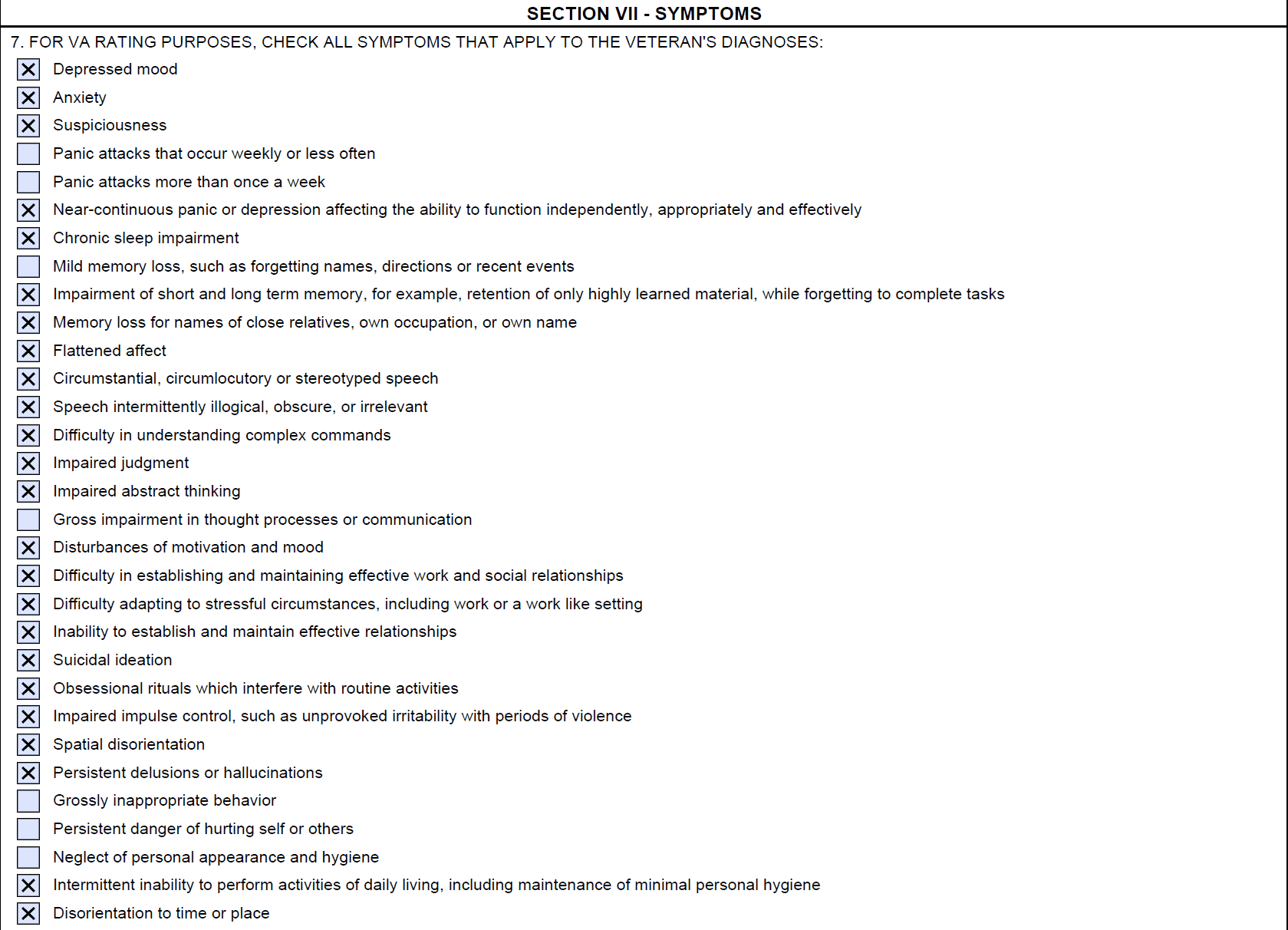How to Increase VA Disability Rating for PTSD in 3 Steps
In this post, I’m sharing my simple, 3-step process so disabled veterans with a current PTSD rating can learn how to increase VA disability rating for PTSD in less time.
Hi Veterans, Brian Reese here, VA disability claim expert, and founder of VA Claims Insider.
In the past 3 years, I’ve seen over 5,000 VA claims for PTSD and I can tell you that in order to get a higher VA rating for PTSD, you MUST follow a 3-step process to increase your rating in less time.
But, first, I want to tell you my #1 PTSD VA claim secret…
VA ratings for PTSD depend upon the severity of your mental health symptoms over time, specifically your level of occupational and social impairment.
How is your PTSD currently affecting your work, life, and social functioning?
If you’re trying to increase VA disability rating for PTSD, you must be prepared to talk about it in detail.
In general, the more severe a veteran’s mental health symptoms are, the higher the VA rating for PTSD they will receive.
WATCH: Actual VA Raters Reveal 3 SECRET VA Claim Tips!
You might also like my post about the Average VA Disability Rating for PTSD (we analyzed 4.7 million veterans with a a current VA rating for PTSD).
So, if you’re underrated for PTSD, the #1 way to get a PTSD increase is to show the VA Rater through new and relevant medical evidence HOW your mental health symptoms have become worse.
The best way to do that is by getting a Disability Benefit Questionnaire (DBQ) for PTSD Review from a private medical provider.
Okay, let’s dive right in and explore my 3-step process to increase your VA PTSD rating in more detail.
3 Steps to Increase VA Disability Rating for PTSD
- Step #1: Obtain a DBQ for PTSD Review from a Psychologist
- Step #2: Get a Buddy Letter for PTSD Increase from a First-Hand Witness
- Step #3: Overprepare for Your C&P Exam for PTSD
PTSD Increase Tip #1: Get a DBQ for PTSD Review
The #1 most effective way to increase VA disability rating for PTSD is to have a private medical provider complete a DBQ Form for PTSD Review.
Why do I say this?
Well, here’s a secret hack: Sometimes, the VA Rater will accept the DBQ on its own merits and grant you a PTSD increase without a C&P exam.

But, even if you do get a C&P exam for PTSD, you’ll be more than ready, because you’ve got new and relevant medical evidence to support HOW your PTSD symptoms are worse.
And remember, the more severe your symptoms, the higher rating you’ll get for PTSD.
On the PTSD DBQ, the most important section is Section IV – Occupational and Social Impairment.
This section corresponds directly to the VA ratings for PTSD, and whatever box the doctor checks is the rating you’re likely to receive.
VA Disability Rating Criteria for PTSD from 0% to 100%
No Rating for PTSD = No mental disorder diagnosis
0% VA Rating for PTSD = A mental condition has been formally diagnosed, but symptoms are not severe enough either to interfere with occupational and social functioning or to require continuous medication.
10% VA Rating for PTSD = Occupational and social impairment due to mild or transient symptoms which decrease work efficiency and ability to perform occupational tasks only during periods of significant stress, or symptoms controlled by continuous medication.
30% VA Rating for PTSD = Occupational and social impairment with occasional decrease in work efficiency and intermittent periods of inability to perform occupational tasks (although generally functioning satisfactorily, with routine behavior, self-care, and conversation normal), due to such symptoms as: depressed mood, anxiety, suspiciousness, panic attacks (weekly or less often), chronic sleep impairment, mild memory loss (such as forgetting names, directions, recent events).
50% VA Rating for PTSD = Occupational and social impairment with reduced reliability and productivity due to such symptoms as: flattened affect; circumstantial, circumlocutory, or stereotyped speech; panic attacks more than once a week; difficulty in understanding complex commands; impairment of short- and long-term memory (e.g., retention of only highly learned material, forgetting to complete tasks); impaired judgment; impaired abstract thinking; disturbances of motivation and mood; difficulty in establishing and maintaining effective work and social relationships.
70% VA Rating for PTSD = Occupational and social impairment, with deficiencies in most areas, such as work, school, family relations, judgment, thinking, or mood, due to such symptoms as: suicidal ideation; obsessional rituals which interfere with routine activities; speech intermittently illogical, obscure, or irrelevant; near-continuous panic or depression affecting the ability to function independently, appropriately and effectively; impaired impulse control (such as unprovoked irritability with periods of violence); spatial disorientation; neglect of personal appearance and hygiene; difficulty in adapting to stressful circumstances (including work or a worklike setting); inability to establish and maintain effective relationships.
100% VA Disability Rating for PTSD = Total occupational and social impairment, due to such symptoms as: gross impairment in thought processes or communication; persistent delusions or hallucinations; grossly inappropriate behavior; persistent danger of hurting self or others; intermittent inability to perform activities of daily living (including maintenance of minimal personal hygiene); disorientation to time or place; memory loss for names of close relatives, own occupation, or own name.
In the example below, the 70% VA rating criteria for PTSD is checked, which indicates “occupational and social impairment with deficiencies in most areas…”
Did you know the average VA disability rating for PTSD is 70%?

Increase PTSD Rating Tip #2: Get a PTSD Buddy Letter from a First-Hand Witness
By law, VA Raters must consider a competent and credible statement in support of a claim from a first-hand witness.
It’s considered a “secondary source of evidence,” which can be used to prove a matter at issue.
In this case, you’re attempting to prove that your PTSD symptoms are worse, and that you deserve a higher VA rating for PTSD by law.
Well, are you going to rely on your written testimony alone or do you think it would help to have another person write a statement on your behalf?
Bingo!
A strong personal statement from your spouse, boss, co-work, or someone who knows you well can help prove that your mental health symptoms are worse, which means you’re likely to get a higher VA rating for PTSD in less time.
So if you’re trying to learn “how to increase VA disability rating for PTSD,” make sure to get at least one VA Buddy Letter!
Wondering How to Write a VA Buddy Letter for PTSD? Click HERE now.
How to Increase VA Disability Rating for PTSD Tip #3: Overprepare for Your C&P Exam for PTSD
The C&P Exam for PTSD is the #1 most important day in determining your final VA rating for PTSD.
It’s the time when an independent examiner performs his/her assessment of you, and documents your PTSD symptoms on that particular day.
The crazy things is we’ve seen VA Raters rely almost solely on the results of your C&P exam…
So, to help you out, I put together my 8 ways you can win your C&P exam for PTSD.
You might also like my Top 5 Tips to Prepare for Your C&P Exam for PTSD.
8 Ways to Win Your VA C&P Exam for PTSD
#1. Know what’s in your medical records! There is no substitute for knowing what’s in your service treatment records, VA medical records, or any private medical records. Review your most recent medical records in detail and know what’s in them.
#2. Review your Disability Benefit Questionnaire (DBQ) for PTSD. Pay close attention to Section IV, which is your level of Occupational and Social Impairment and Section VII, which is your current Symptoms of PTSD. Notice how the “symptoms” checked below link directly to the VA rating criteria under the law.

#3. Review the eCFR, Title 38, Part 4, Schedule for Rating Disabilities for Mental Health Conditions. You must know the keywords and symptoms that match to the various ratings for PTSD. The PTSD Rating Scale ranges from 0% to 100% with breaks at 10%, 30%, 50%, and 70%.
Check our my detailed post on >> 38 CFR PTSD <<
#4. Do NOT have your best day…this means you need to tell the C&P examiner how you are on your very WORST days.
#5. Be UNFOMFORTABLY VULNERABLE…this means that if it’s uncomfortable or awkward for you to talk about, you need to talk about it! For example, “My PTSD symptoms are so severe that I can’t get an erection anymore, and it’s significantly harmed my relationship with my spouse. In fact, we’ve been sleeping in separate bedrooms for the past 6 months.”
#6. If you’re trying to increase your VA rating for PTSD, your symptoms need to match a current level of “Occupational and Social Impairment” on the PTSD DBQ form.
#7. Know your true story cold…and potential in-service stressors (or other service-connected disability) that caused or made your PTSD VA worse. The good news is you’re already service-connected for PTSD, so you don’t need to prove the Stressor Requirements again. Rather, you’re explaining to the C&P examiner how your PTSD symptoms have gotten worse since your previous rating decision.
#8. You must be prepared to talk about your life in detail. Before joining the military. During the military. And after your active duty service. Make sure you can speak to your symptoms in detail and HOW your PTSD is limiting and affecting your work, life, and social functioning. Ultimately, your level of impairment is what determines your PTSD rating.
About Brian T. Reese
Brian Reese is VA claim expert, former military officer, and founder of VA Claims Insider – “The Most Trusted Name in VA Disability Claims.”
His frustration with the 8-step VA disability claims process led him to create “VA Claims Insider,” which provides U.S. military veterans with FREE high-value resources for successfully submitting or re-submitting a winning VA disability compensation claim.

Brian is also the CEO of Military Disability Made Easy, which is the world’s largest free searchable database for all things related to DoD disability and VA disability claims and has served more than 4,600,000 military members and veterans since its founding in 2013.
His eBook, the “9 Secrets Strategies for Winning Your VA Disability Claim” has been downloaded more than 300,000 times in the past three years and is the #1 rated free VA disability claims guide for veterans.
He is a former active duty Air Force officer with extensive experience leading hundreds of individuals and multi-functional teams in challenging international environments, including a combat tour to Afghanistan in 2011.
Brian is a Distinguished Graduate of Management from the United States Air Force Academy, Colorado Springs, CO and he holds an MBA from Oklahoma State University’s Spears School of Business, Stillwater, OK, where he was a National Honor Scholar (Top 1% of Graduate School class).
